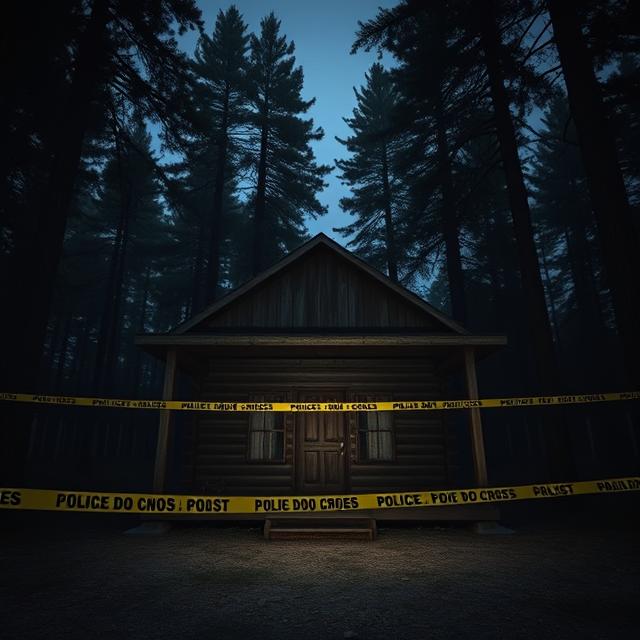In the secluded, pine-shrouded Sierra Nevada mountains of Northern California lies the ghost of Keddie Resort, a former idyllic mountain getaway that now stands as a monument to a dark and brutal past. It was here, on the morning of April 12, 1981, that one of the most savage and baffling crimes in American history was discovered. Inside the blood-soaked walls of Cabin 28, a mother, her son, and his friend were found slaughtered, and a young girl was missing, seemingly vanished into thin air. For over four decades, the Keddie Cabin Murders have haunted the public consciousness, a chilling saga of horrific violence, a profoundly flawed police investigation, and a community’s desperate, ongoing search for justice.
A Scene of Unspeakable Horror
The morning began with a mother’s worst nightmare. 14-year-old Sheila Sharp, returning from a sleepover at a neighboring cabin, opened the door to Cabin 28 to a scene of unimaginable carnage. On the living room floor lay the bound and brutalized bodies of her mother, 36-year-old Glenna “Sue” Sharp; her 15-year-old brother, John; and John’s 17-year-old friend, Dana Wingate. The victims had been bound with electrical tape and appliance wire, and had been viciously stabbed, bludgeoned, and beaten. A bent steak knife and a bloody hammer were found at the scene, testament to the frenzied violence of the attack.
Incredibly, Sheila’s two younger brothers, Rick and Greg (ages 10 and 5), along with their friend, Justin Smartt, were found physically unharmed in an adjacent bedroom. They had slept through the entire horrific ordeal, a fact that both saved their lives and added another layer of profound mystery to the case.
The horror, however, was not yet complete. The Sharp’s 12-year-old daughter, Tina, was missing. Initially, police held out hope that she had been abducted by the killer or killers and might still be alive. An intensive search of the surrounding wilderness began, but as days turned into weeks, hope for Tina’s safe return began to fade.
A Botched Investigation from Hour One
The initial investigation into the Keddie murders, conducted by the Plumas County Sheriff’s Office, is now widely regarded as a case study in incompetence and missed opportunities. From the moment they arrived, critical errors were made that would cripple the case for decades to come:
- Contaminated Crime Scene: The scene was not properly secured. Dozens of people were allowed to wander in and out of the cabin, potentially destroying or contaminating crucial evidence. One responding officer allegedly washed his hands in a sink, disturbing blood evidence.
- Overlooked Evidence: Blood spatter on the walls and other surfaces was not properly collected or analyzed. A bloody fingerprint on the cabin’s railing was mishandled. The potential significance of the weapons left at the scene was not fully realized for years.
- Dismissed Witness Testimony: The most critical failure was the handling of the young eyewitness, Justin Smartt. Shortly after the murders, Justin told investigators that he had witnessed the attacks. He described seeing two men—one with a mustache and glasses, the other clean-shaven—arguing with Sue Sharp. He claimed to have seen John and Dana arrive and join the fight, and even described seeing one of the men take Tina from the cabin. However, under hypnosis conducted by a sheriff’s deputy, he gave a conflicting account, identifying a different man. The police, for reasons that remain baffling, chose to dismiss his initial, detailed testimony as the fantasy of a traumatized child.
The investigation quickly grew cold. Despite numerous tips and interviews, no arrests were made. The case became a fixture of local lore, a ghost story told around campfires, while the families of the victims were left without answers.
The Missing Piece: Tina Sharp
For three long years, Tina Sharp’s fate remained a mystery. Then, in April 1984, a bottle collector stumbled upon a human skull and a jawbone in a remote area near Camp Eight in neighboring Butte County, some 50 miles from Keddie. An anonymous phone call to the Sheriff’s office claimed the remains belonged to Tina. Dental records confirmed the horrifying truth. An audio recording of the anonymous call was made, but like so much other evidence in the case, it was inexplicably lost by investigators. The discovery of Tina’s remains officially reclassified her case from a missing person to a homicide, but it brought investigators no closer to finding her killer.
The Prime Suspects: A Neighbor and His Accomplice
While the case remained officially unsolved, two names consistently emerged as the primary suspects: Martin “Marty” Smartt and John “Bo” Boubede. Marty Smartt was the father of Justin Smartt, the young boy who had been in the cabin during the murders. He was a known drug user and had a volatile temper. Boubede was a friend of Smartt’s, a man with a criminal record from Chicago who was reportedly connected to organized crime.
The connection to the victims was personal and chilling. Marty Smartt was a neighbor and was acquainted with the Sharp family. His wife, Marilyn, had reportedly been counseled by Sue Sharp, who encouraged her to leave her abusive husband. This led to the prevailing theory that the motive for the murders was revenge. Smartt, enraged that Sue had interfered in his marriage, allegedly went to the cabin to confront her, with Boubede as his muscle. The confrontation escalated, and when John and Dana unexpectedly arrived, they too became victims of the killers’ rage. Tina, it is believed, may have witnessed the initial attack and was abducted to silence her.
In the days following the murders, Marty Smartt abruptly left Keddie. He later sent a letter to his wife, Marilyn, in which he wrote, “I’ve paid the price of your love & now that I’ve bought it with four people’s lives, you tell me we are through… Great! What else do you want?” This letter, a thinly veiled confession, was given to police but was largely ignored at the time.
Years later, a therapist who had counseled Marty Smartt came forward, stating that Smartt had confessed to him that he had killed Sue Sharp, but denied killing the children. Both Smartt and Boubede died years ago without ever being charged for the crimes.
A Cold Case Reborn
For decades, the Keddie case files gathered dust. But in the 2010s, a new Plumas County Sheriff, Greg Hagwood, and a dedicated team of investigators, armed with modern technology and a fresh perspective, reopened the case, determined to finally bring it to a close.
This new investigation uncovered stunning new evidence and re-examined old leads that had been inexplicably abandoned:
- The Hammer: Investigators located a steel hammer that Marty Smartt had allegedly thrown into a local pond shortly after the murders. The hammer matched the description of one of the murder weapons.
- The Confession: Marilyn Smartt, Marty’s ex-wife, confirmed in a new interview that she believed her husband and Boubede were responsible. She admitted that on the night of the murders, Marty and Boubede had returned late, and the next morning, they had burned something in the woodstove.
- DNA Evidence: A crucial piece of evidence—a strip of medical tape used to bind Dana Wingate—was re-analyzed. Investigators announced they had found a DNA profile on the tape that matched that of a known, living suspect, though they have not yet released the person’s name.
The renewed investigation, chronicled in the documentary “Cabin 28: The Keddie Murders,” has brought the case back into the national spotlight. It has exposed the deep flaws of the original investigation and has given hope to the surviving family members that they might finally see justice.
A Legacy of Pain and Persistence
The Keddie Cabin Murders are more than just a cold case; they are a tragic story of a family destroyed, a community terrorized, and a justice system that failed its victims. The image of Cabin 28, now demolished, remains a scar on the beautiful landscape of the Sierra Nevada. It stands as a symbol of the evil that can lurk in the most peaceful of places and the institutional failures that can allow that evil to go unpunished.
Yet, it is also a story of incredible persistence. It is the story of Sheila Sharp, who has never stopped fighting for her family. It is the story of a new generation of law enforcement, determined to right the wrongs of the past. And it is the story of a community that has never forgotten the four lives lost on that terrible night in 1981. The case may be cold, but for those who seek the truth, the fire has never gone out.
Want to explore the shadows even deeper? For more chilling cases like this, visit SinisterArchive.com, where the legends are real.




